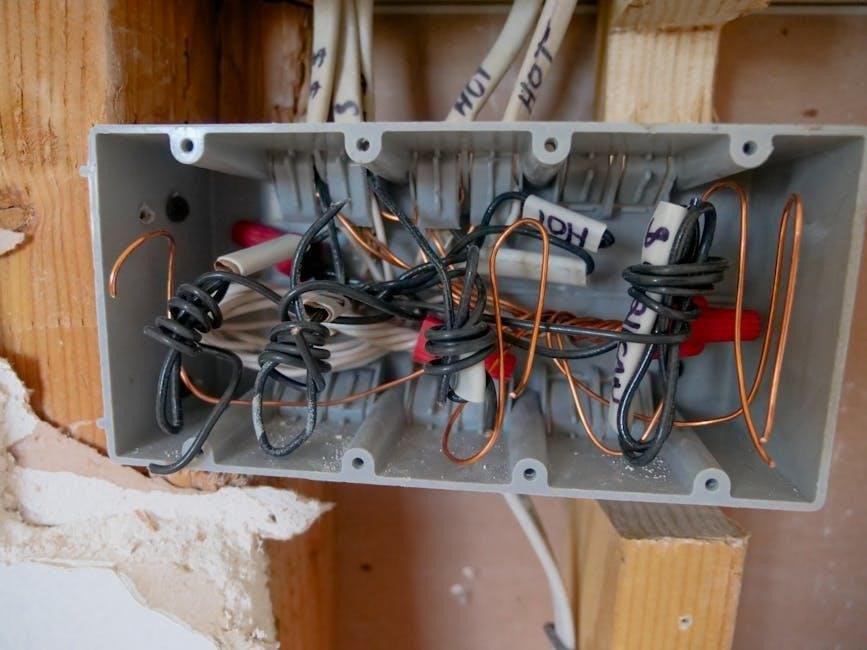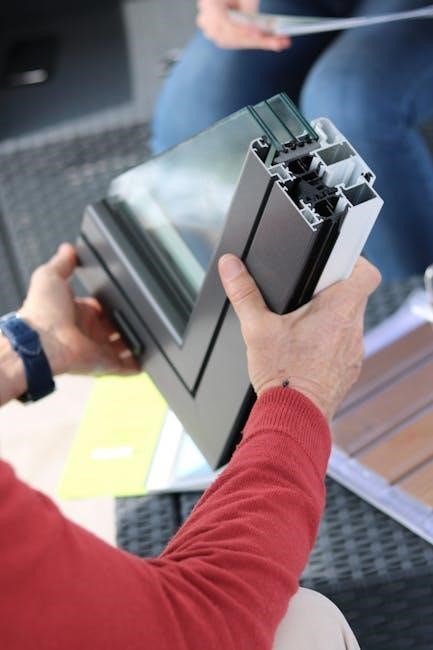The Honeywell VISTA-128BPT is a commercial burglary partitioned security system designed for advanced protection and flexibility, offering multiple user access levels and scalable zone configurations.
1.1 Overview of the Vista 128BPT Security System
The Honeywell VISTA-128BPT is a commercial burglary partitioned security system designed for advanced protection and flexibility. It supports up to 128 zones, multiple partitions, and various user access levels, making it ideal for businesses with complex security needs. The system integrates burglary, fire, and emergency protection, offering features like scheduling, remote access, and customizable authority levels. Its partitioned design allows different users to manage separate areas independently, while global arming enables unified control. The system is scalable and adaptable, ensuring robust security solutions for diverse commercial environments.
1.2 Key Features and Benefits
The Honeywell VISTA-128BPT offers a range of features designed to enhance security and user convenience. It supports up to 128 zones, allowing comprehensive coverage of large premises. The system provides scheduling and automation capabilities, enabling users to program security settings and device controls. With remote access and monitoring, users can manage their security from anywhere. The system also features partitioned control, allowing multiple independent security areas. Additional benefits include integration with other systems, such as fire and emergency solutions, and advanced access control with customizable authority levels. These features make it a robust and adaptable security solution.
1.3 Differences Between Vista-128BP and Vista-250BP
The Vista-128BP and Vista-250BP differ primarily in capacity and features; The Vista-128BP supports up to 128 zones and 250 user codes, while the Vista-250BP supports 250 zones and 250 user codes. The Vista-128BP has a 2,500-event log, whereas the Vista-250BP offers a 10,000-event log. The Vista-128BP includes a Remote Keypad Sounder option, which is not available in the Vista-250BP. Both systems share similar features like scheduling and automation but cater to different scale requirements.

System Overview and Architecture
The Honeywell VISTA-128BPT system includes a main control panel, keypads, and sensors, providing burglary, fire, and emergency protection. It supports up to 8 partitions for flexible security management and scalability, ideal for commercial applications.
2.1 Hardware Components

The VISTA-128BPT system consists of a main control panel, keypads, and a variety of sensors. The control panel serves as the central processing unit, managing all security operations. Keypads provide user interaction, displaying system status and allowing code entry. Sensors detect intrusions, fires, or emergencies, while communication modules enable remote monitoring. Additional hardware includes expansion modules for increased zone capacity and advanced features. This modular design ensures scalability and flexibility, meeting diverse security needs for commercial environments.
2.2 Software Components
The VISTA-128BPT system relies on advanced software for programming and operation. This includes the control panel’s firmware, which manages security protocols and user interactions. Programming tools enable technicians to configure zones, user codes, and authority levels. Remote access software allows users to monitor and control the system via internet or mobile apps. Additionally, diagnostic software aids in troubleshooting and system maintenance. Regular updates from Honeywell ensure enhanced security features and system performance. These software components are essential for optimizing the system’s functionality and ensuring reliable security operations.
2.3 System Architecture and Connectivity
The VISTA-128BPT system features a modular architecture designed for scalability and integration. It includes a central control panel, keypads, and sensors, ensuring robust security coverage. The system supports both wired and wireless devices, offering flexibility in installation. Connectivity options include RS-232 and Ethernet interfaces for remote monitoring and programming. It integrates seamlessly with other systems, such as home automation and fire alarm panels, enhancing overall security management. Remote access capabilities allow users to monitor and control the system via mobile apps or web interfaces, ensuring convenience and real-time alerts. This architecture ensures reliable performance and adaptability to various security needs.

Pre-Installation Requirements
Ensure compatibility with existing systems, verify power supply requirements, and configure network settings before installation to guarantee smooth operation of the VISTA-128BPT security system.
3.1 Compatibility Check
Before installing the VISTA-128BPT, ensure all components are compatible with existing hardware and software. Verify that sensors, keypads, and communication devices meet Honeywell’s specifications. Check for approved devices to avoid system malfunctions. Compatibility ensures seamless integration and optimal performance. Refer to the installation manual for a list of supported devices. Testing with non-approved devices may void the warranty or cause operational issues. Always use Honeywell-certified products for reliability and security. Proper compatibility guarantees a robust and efficient security system.
3.2 Power Supply Requirements
The VISTA-128BPT requires a stable power supply to ensure reliable operation. The system operates on 16.5VAC, 20VA power, which must be provided by a Honeywell-approved transformer. A backup battery (12V, 4Ah) is essential for uninterrupted operation during power outages. Proper ventilation and grounding are critical to prevent overheating and electrical interference. Ensure all connections are secure and meet the specifications outlined in the installation manual. Using low-quality or incompatible power supplies may result in system malfunctions or reduced performance. Always follow Honeywell’s guidelines for optimal functionality and safety.
3.3 Network and Communication Setup
Configuring the network and communication settings for the VISTA-128BPT ensures seamless integration with monitoring services and remote access. The system supports IP and cellular communication modules, enabling reliable connectivity. Installers must program the Communication Device settings, including IP addresses, port numbers, and signal strength for cellular units. Ensure proper wiring and antenna placement for optimal performance. Regular signal strength tests are recommended to maintain stable communication. Refer to the installation manual for specific configuration instructions and troubleshooting guides to avoid connectivity issues. Proper setup guarantees efficient monitoring and remote system control.

Installation Process
The VISTA-128BPT installation involves a systematic approach, starting with hardware setup, followed by software configuration, and concluding with network integration to ensure a secure and functional system.
4.1 Hardware Installation Steps
The hardware installation for the VISTA-128BPT begins with mounting the control panel in a secure, central location. Install sensors and detectors strategically throughout the premises, ensuring all entry points are covered. Connect wires carefully to avoid damage and interference. Power the system using the recommended supply to maintain stability. Finally, test all components to ensure proper functionality and integration. This step-by-step process ensures a robust and reliable security setup. Always follow the manufacturer’s guidelines for optimal performance and safety.
4.2 Software Configuration
After hardware installation, configure the VISTA-128BPT software by defining zones, user codes, and authority levels. Use the keypad to access programming mode. Assign each zone a type (e.g., perimeter or interior) and link it to specific sensors. Set up unique user codes with varying authority levels to restrict or grant access to system functions. Enable global arming for users with higher authority to control multiple partitions simultaneously. Ensure all settings align with the system’s operational requirements for optimal security and functionality. Refer to the manual for detailed programming instructions.
4.3 Network Integration
Integrate the VISTA-128BPT system into your network by connecting it to a local area network (LAN) or the internet. Configure the system’s IP settings using the keypad or remote programming tools. Enable communication modules, such as the 7847i, for internet and cellular connectivity. Ensure remote monitoring and control by setting up the system with a compatible monitoring service. Verify network settings and test communication to confirm successful integration. Use secure protocols to protect data transmission and ensure system updates are applied for optimal performance and security. Refer to the manual for detailed network configuration steps.

Programming the System
Program the VISTA-128BPT by configuring zones, user codes, and authority levels. Set global arming options and partitioning for customized security. Refer to the manual for detailed instructions.
5.1 Zone Configuration
Zone configuration is essential for tailoring the VISTA-128BPT system to your security needs. Each zone can be designated as a perimeter or interior zone, with specific entry and exit delays. Users can bypass zones temporarily while arming the system, ensuring flexibility. The system supports up to 128 zones, allowing for detailed customization. Proper zone setup ensures accurate detection and response to potential threats, enhancing overall security effectiveness. Refer to the manual for step-by-step instructions on configuring zones and assigning their respective properties.
5.2 User Code Setup
The VISTA-128BPT allows for secure user code setup, enabling multiple access levels. Each user is assigned a unique code linked to one of six authority levels, defining their system access. Users can arm, disarm, or bypass zones based on their assigned permissions. Temporary codes can be created for limited access. The system ensures that users with lower authority cannot modify or delete codes of higher-level users. This feature enhances security by restricting unauthorized changes. Refer to the manual for detailed steps on assigning and managing user codes effectively.
5.3 Authority Levels and Access Control
The VISTA-128BPT system supports six distinct authority levels, ensuring precise access control. These levels define the actions users can perform, such as arming, disarming, or bypassing zones. Higher-level users, like Masters or Managers, can modify or delete lower-level user codes, while lower-level users have restricted access. Authority levels prevent unauthorized changes, enhancing system security. For instance, a user with lower authority cannot alter codes of the same or higher authority, ensuring a hierarchical control structure. This feature is crucial for maintaining system integrity and preventing unintended modifications.
5.4 Global Arming and Partitioning
The VISTA-128BPT system allows for global arming, enabling users to arm or disarm all partitions simultaneously with a single command. This feature is particularly useful for centralized security management. Additionally, the system supports partitioning, where each partition operates independently, catering to different security needs within a shared system. Users with appropriate authority levels can arm or disarm specific partitions, ensuring flexibility and tailored protection. Global arming can be customized to include or exclude certain partitions, providing enhanced control over system-wide security operations. This feature is ideal for multi-zone or multi-user environments.

Testing and Verification
Testing and verification are critical steps to ensure the VISTA-128BPT system operates reliably. Functional testing verifies all components, including sensors and keypads, are working correctly. Troubleshooting identifies and resolves issues, while system validation confirms the setup meets security requirements. These steps ensure optimal performance and reliability.
6.1 Functional Testing
Functional testing ensures the VISTA-128BPT system operates as intended by verifying all components, including sensors, keypads, and zones. Test each zone by triggering sensors to confirm alarms activate correctly. Check keypad functionality, ensuring proper display of messages and responses to user inputs. Validate the arming and disarming processes, as well as entry and exit delays. Test any integrated devices, such as sirens or cameras, to ensure they respond appropriately. This step confirms that the system is fully operational and ready for use, providing reliable security coverage. Regular testing is essential for maintaining system performance.
6.2 Troubleshooting Common Issues
Common issues with the VISTA-128BPT system include zone faults, communication errors, and keypad malfunctions. Start by checking zone descriptors for open or faulty zones. Verify wiring connections and ensure all devices are powered. For communication issues, test the phone line or IP connectivity. Keypad errors may require resetting or reprogramming. Use diagnostic tools to identify system faults and consult the manual for detailed solutions. Regular system restarts can often resolve temporary glitches. Persistent issues may require professional assistance to ensure optimal system performance and security.
6.3 System Validation
System validation ensures the VISTA-128BPT operates correctly after installation and configuration. Test all zones by triggering sensors to confirm proper alarm responses. Verify communication with monitoring centers and check keypad functionality. Ensure user codes and authority levels work as intended. Perform a full system test, including arming and disarming, to validate all features. Review event logs to confirm accurate recording of system activities. This step ensures reliability and security, providing peace of mind for users. Regular validation is crucial for maintaining optimal system performance.

Advanced Features
The VISTA-128BPT offers advanced features like scheduling, remote access, and integration with smart systems, enhancing security and convenience for users.
7.1 Scheduling and Automation
The VISTA-128BPT system supports robust scheduling and automation capabilities, allowing users to set specific times for arming and disarming the system. This feature enhances security by automating routines, reducing the need for manual intervention. Users can program up to 20 timers to control various devices, such as lights or appliances, integrating seamlessly with the security setup. Additionally, the system’s automation features can be tailored to specific user needs, ensuring a customized and efficient security solution. This functionality is detailed in the installation manual, providing clear guidance for setup and configuration.
7;2 Remote Access and Monitoring
The VISTA-128BPT system offers remote access and monitoring capabilities, enabling users to control and view their security setup via web and mobile applications. Through Honeywell’s Total Connect platform, users can receive real-time notifications, arm or disarm the system, and monitor live video feeds. This feature enhances convenience and security by allowing users to manage their system from anywhere. The installation manual provides detailed instructions for setting up remote access, ensuring seamless integration with existing security infrastructure. This functionality is ideal for users seeking enhanced control and peace of mind.
7.3 Integration with Other Systems
The VISTA-128BPT system seamlessly integrates with various devices and platforms, enhancing its functionality. It supports integration with lighting systems like Lutron RadiRA 2, enabling automated lighting control based on security events. Additionally, it can connect with HVAC systems and other smart home devices. The system also integrates with Honeywell’s Total Connect platform for remote monitoring and control. Users can program custom scenarios to trigger actions across multiple systems. This versatility allows the VISTA-128BPT to adapt to diverse security and automation needs, ensuring a comprehensive and interconnected system.

Security Best Practices
Regularly update software, monitor system activity, and maintain physical security of components to ensure optimal performance and protect against unauthorized access.
8.1 Physical Security Measures
Ensure all system components, including control panels and keypads, are securely installed in tamper-proof locations. Regularly inspect wiring and connections for damage or unauthorized access. Use high-quality locks and consider environmental factors to prevent damage from moisture or extreme temperatures. Implement surveillance cameras near security equipment to deter tampering. Train authorized personnel on proper handling and maintenance to uphold system integrity. These measures safeguard against physical breaches and ensure reliable operation.
8.2 Regular System Updates
Regular system updates are crucial for maintaining optimal performance and security. Honeywell periodically releases firmware and software updates to enhance functionality, fix vulnerabilities, and improve compatibility. Ensure your VISTA-128BPT system is updated by checking Honeywell’s official website or contacting their support. Updates may include new features, bug fixes, or security patches. Always follow the manufacturer’s instructions for installation to avoid system instability. Keeping your system updated ensures it remains reliable and secure, protecting your property effectively. Regular updates also prevent potential issues with compatibility or performance degradation over time.
8.3 Monitoring and Maintenance
Regular monitoring and maintenance are essential to ensure the VISTA-128BPT system operates efficiently. Check sensors and keypad functionality periodically to prevent false alarms. Dust and debris can interfere with sensors, so clean them regularly. Ensure all wiring is secure and undamaged. Monitor system logs for unusual activity and address any issues promptly. Routine maintenance, such as battery checks for wireless devices, helps prevent system failures. Scheduling professional inspections annually can identify and resolve potential problems before they escalate, ensuring continuous protection and reliability.

Troubleshooting Guide
The VISTA-128BPT system includes diagnostic tools to identify and resolve issues. Check error codes, keypad functionality, and communication issues. Use system logs to trace problems and ensure proper operation.
9.1 Common Issues and Solutions
Common issues with the VISTA-128BPT include zone faults, keypad errors, and communication failures.
For zone faults, check sensors and wiring connections. Keypad issues may require updating firmware or replacing faulty units.
Communication problems can be resolved by verifying network settings and ensuring all devices are connected properly. Always refer to the diagnostic tools in the system menu for detailed error codes and guided solutions. Regular system checks can prevent recurring issues and ensure optimal performance.
9.2 Diagnostic Tools and Techniques
The VISTA-128BPT system provides advanced diagnostic tools to identify and resolve issues.
Use the system’s event logs to review historical data and pinpoint errors.
Keypad displays show error codes, guiding technicians to specific problems.
Utilize the TEST key to run diagnostics on zones and devices.
For communication issues, check network settings and verify panel connectivity.
Regularly updating firmware ensures optimal performance and security.
These tools enable quick troubleshooting and minimize system downtime, ensuring reliable operation.
9.3 Emergency Procedures
In case of an emergency, the VISTA-128BPT system offers robust response features.
Ensure all users know the emergency codes to trigger immediate alerts.
Test panic buttons regularly to confirm functionality.
Program emergency contacts for instant notifications.
Conduct regular evacuation drills to familiarize users with procedures.
Use the system’s global arming to secure the premises swiftly;
Review event logs post-emergency to assess response effectiveness.
Stay informed of system status updates via remote monitoring.
The VISTA-128BPT system offers advanced security solutions with flexible partitioning, scalable configurations, and reliable performance, making it ideal for both residential and commercial security needs.
10.1 Summary of Key Points
The VISTA-128BPT is a powerful security system offering burglary, fire, and emergency protection. It supports up to 128 zones, multiple partitions, and various user access levels. The system provides flexible arming modes, zone bypassing, and event logging. Designed for scalability, it integrates with wireless devices and offers advanced features like global arming and scheduling. The VISTA-128BPT is ideal for commercial and residential applications, ensuring robust security while maintaining user-friendly operation. Its adaptability and reliability make it a top choice for comprehensive security solutions.
10.2 Final Thoughts on the Vista 128BPT System
The VISTA-128BPT stands out as a versatile and reliable security solution, blending advanced features with user-friendly operation. Its partitioned design allows multiple users to share the system while maintaining individual security needs. With robust programming options, remote access capabilities, and seamless integration with other systems, it offers a comprehensive security approach. Regular updates and maintenance ensure optimal performance and adaptability to evolving security demands. Overall, the VISTA-128BPT is a superior choice for those seeking a scalable, efficient, and modern security system for various applications.
